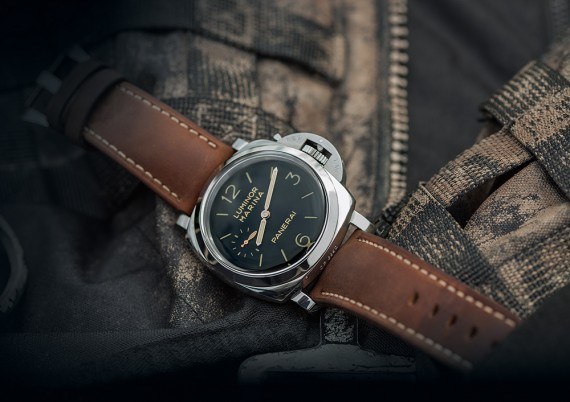Diving With The Panerai Luminor Marina 1950 3 Days Acciaio Top Quality Knock Off Watch
In this review from the WatchTime archives, a frogman re-creates a dip from the 1950s to test the historically inspired Panerai Luminor Marina 1950 3 Days Acciaio. When you look in Panerai watches which have been modeled on their historical predecessors, and, like them, possess static bezels and leather straps, would you wonder if frogmen actually wore the first models in their dives? In the end, a rotating bezel and metal bracelet or rubber band are now considered compulsory for dip watches.
Of course, there is ample evidence that military frogmen really did wear these early Panerais. We hunted for hints with a seasoned frogman who is a part of the Historical Diving Society, an global organization dedicated to preserving and protecting diving heritage. He donned an old-fashioned diving suit and brought along vintage equipment. In addition, he brought along the Panerai Luminor Marina 1950 3 Days Acciaio, which appears like a Panerai luminor marina 1950 47mm replica watch from the 1950s, so we could revive a bygone age and experience how the frogmen of the past may have felt.
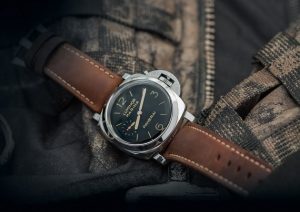
Panerai created its first prototype dive watches for Italian army sailors in 1936. From the mid-1950s, Panerai introduced a new version using a curved, crown defense bridge. It became famous as the Luminor. Until 1993, Panerais were sold only to the army. Before then, collectors who desired a Panerai watch had to find one in an auction.
The Panerai Luminor Marina 1950 3 Days Acciaio that we took with us our dip looks very much like its own ancestor. Like the first, the watch comes with a 47-mm situation along with a crown protection bridge. The tiny seconds subdial can also be true to the earlier model: approximately 1956, Panerai luminor marina 1950 3 days automatic replica watches replaced the watch’s Rolex hand-wound movement, which had no seconds and a 36-hour power reserve, using an Angelus caliber that had a small-seconds display and an eight-day electricity reserve. Although our evaluation watch has a power reserve of 3 days, we feel that it’s more than sufficient for a hand-wound watch.
Then as now, it is important for a military diver to use a”rebreather,” which is a closed circulation diving device. It makes a very long dive possible, while ensuring no telltale bubbles rise to the surface and give away the diver’s location. Unlike recreational sailors, a military frogman doesn’t take a massive tank filled with pressurized atmosphere with himhe carries instead a more compact tank filled with oxygen which, despite its smaller volume, enables him to remain underwater for two to three hours. The atmosphere that he exhales is treated using soda lime inside the device to stop carbon dioxide retention. But the drawback of the system is that as the depth increases, breathing molecular oxygen increased partial pressures may quickly result in oxygen poisoning. That is why divers who use these devices can safely descend to only about half an hour, a depth that is comparatively shallow yet fantastic enough for most military assignments. These divers typically swim for extended stretches, remaining under water and so out of sight, and only after they’ve swum well beyond enemy lines do they come ashore to run reconnaissance or blow up a bridge.
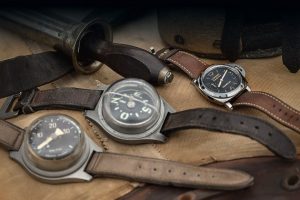
Knowing his location is crucial to get a frogman. A bathometer or depth gauge, a compass, a sketch of the shore’s contours and, needless to say, a watch are significant equipment for him. For our dip, as well as his view, Höner strapped on his forearm an instrument to survey the shore. This piece of equipment allows him to gather and record cartographic data about a stretch of shoreline, information which may be utilised to support amphibious landing operations by frogmen on subsequent missions. We chose to do without some other pieces of gear taken by frogmen, such as weapons and explosives.
When you look at the list of jobs performed by military sailors who normally swim at shallow depths for extended periods of time, it is possible to see why a rotating bezel for presetting the dive time is not really necessary — even though this function debuted as early as 1953 with the coming of the Rolex Submariner. Frogmen used Panerai’s watch mostly at depths of six meters or not, on missions that lasted over 1 hour. Unlike deeper dives, these excursions do not require decompression stops, so a rotating bezel is not of much use.
The watch functioned much more as a navigational instrument: for instance, a diver could pay a partial stretch resulting toward his ultimate destination by swimming along a preset compass course for a predetermined length of time. There was no sensible means to assess the swimmer’s speed, therefore minutes markings weren’t very important.
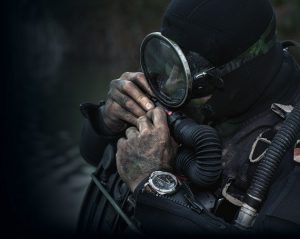
Most military missions took place — and still occur now — under cover of darkness, so brightly luminous dials are completely needed. Panerai luminor marina 1950 3 days 47mm fake watch contributed significantly to improving night legibility by developing its own light-emitting luminous substance for its Radiomir and replacing it in the Luminor with a similarly bright but less radioactive material. The sandwich-style dial was equally important to increased legibility. The dial consists of a lower disc bearing the luminous substance and an upper disk where the indexes and numerals have been cut out. This empowers Panerai to use more luminous material than would be possible when the numerals were printed or painted on the dial. The method, which is still employed today, cannot be employed to make luminous indexes for the individual minutes: cutting on 60 strokes to the upper disk would jeopardize the flow of the durability. That’s why the markings were, and are still, just at five-minute intervals, but they are sufficiently precise for long missions.
We chose a leather strap for our test watch, rather than a rubber , which also comes with the watch, because Panerai’s original version had a leather strap. The instructions which come with the watch expressly state the leather strap can be employed on dives, but we had to overcome our reluctance to take this costly strap to the chilly water. It is surprising but true that Panerai’s leather straps are as convenient as for immersion in water since the leather is almost untreated. Extension pieces for sailors were unavailable ages back, so we chose a particularly long XL strap which could fit across the cuff of a diving suit.
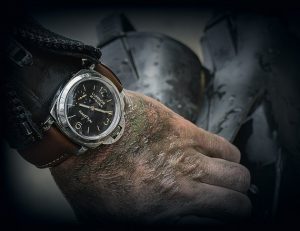
Now Höner has donned his diving suit, he begins smearing his face and hands using camouflage makeup, which was also used in the 1950s. The mask dates from the era when Panerai luminor marina 1950 3 days automatic titanio clone was equipping Italian Navy frogmen. He rinses his mask, slips his rebreather’s mouthpiece between his teeth, glances at his watch and slides softly into the water without even leaving even the smallest hint of an air bubble.
Under water and from fading daylight, the Luminor’s crystal is almost nonreflective and its big dial is quite easy to read, thus fulfilling its important requirement. Our frogman is nicely concealed thanks to the camouflage makeup and mud, but his view’s polished instance catches our eye. The original models were equally glistening: we can not explain why Panerai luminor marina 1950 3 days pam 312 replica did not opt to give them a satin finish, which would have caused fewer reflections and been less inclined to reveal that the diver’s place. Is it that Italian layout has got the upper hand ?
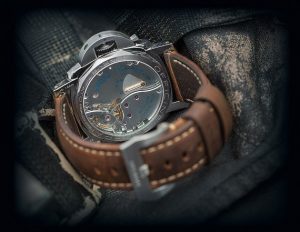
The watch is powered with the hand-wound, in-house Caliber P.3001. With a diameter of 161/2 lignes (37.2 mm), it has nearly the same size as the original 16-ligne Angelus motion. Forgoing a regulator mechanism, the caliber can be finely adjusted by turning weight screws along the balance rim. This guarantees that the balance spring could breathe freely. The balance oscillates beneath a solid equilibrium bridge.
A couple of special features distinguish the watch’s operation. When the crown is pulled out to its original position, the hour can be flashed in hourly increments without affecting the place of the moments hand. This is convenient once you’re traveling to a different time zone or at the time at the spring and autumn: you are able to reposition the hour hand without quitting the seconds or minutes hands. Should you pull the crown out to its second place, you can fix the minutes hand — along with the hour hand along with it — in the typical manner. The seconds hand jumps to zero through this process, thus making it easier to synchronize your watch with a radio time signal.
Underwater legibility and water resistance had been the watches’ primary virtues in these days.
If you use the suits and take the equipment used by frogmen decades before, it immediately becomes apparent exactly what feats those amphibious fighters achieved with little more than fortitude. Panerai watches were well suited for their military assignments at shallow depths and during many long hours, even though they wouldn’t fulfill the standards of today’s divers’ watches. And as our evaluation showedthe leather straps used back then were very capable of accompanying a military leader. The historical watches aren’t only functional, but also handsome: As now, we could thank Italian design for their rugged good looks.

